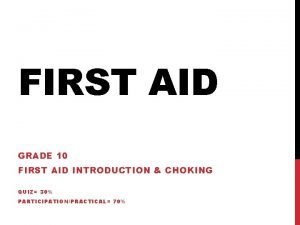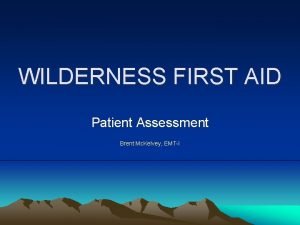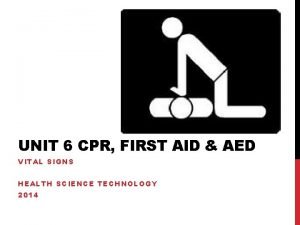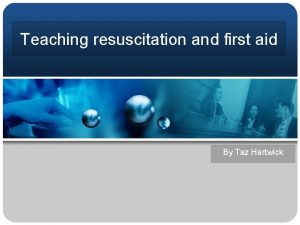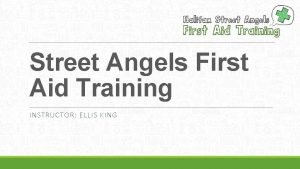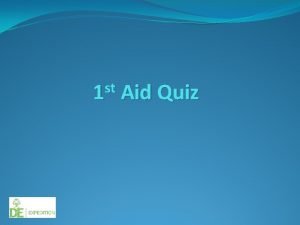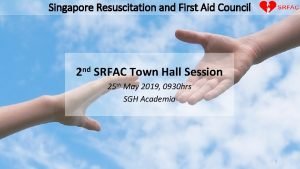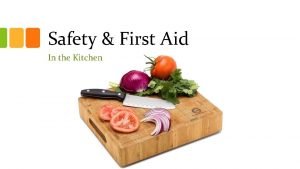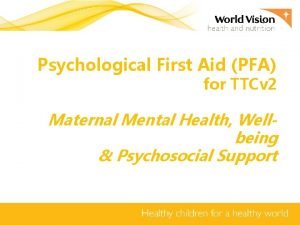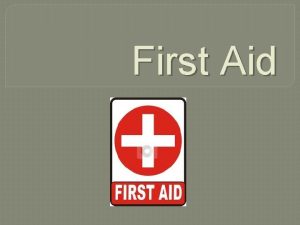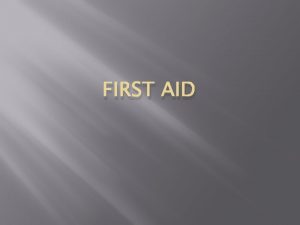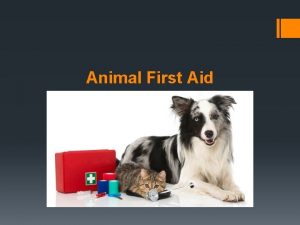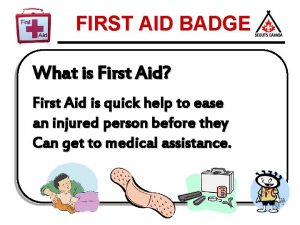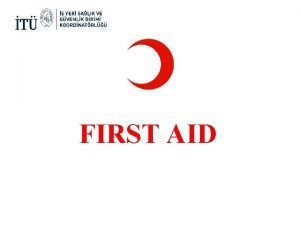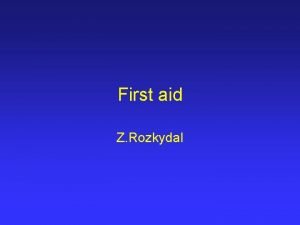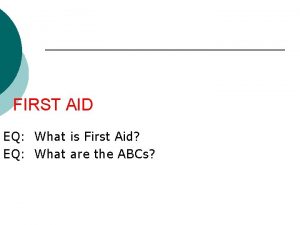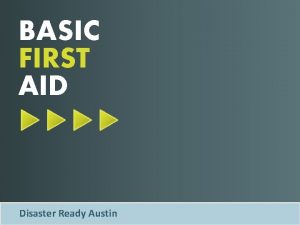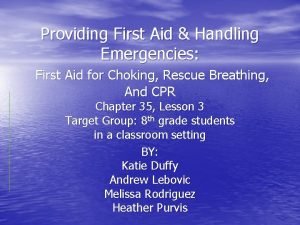First Aid First Aid It is important to

















- Slides: 17

First Aid

First Aid § It is important to have skills that will keep you and others safe. § First Aid is about using your common sense and training in order to keep people safe.

Calling for help § Calling for help is the most important thing you can do in an emergency. § If others are around, let them know there is an emergency. § If you can not help the person in a real emergency by yourself and you are alone, dial 911.

ABCs of First Aid

Difficulty Breathing § If a person has trouble breathing: § Call 911 immediately § Check if the person is choking § Remove any tight clothing § Check if the person has any emergency medication or medial needs https: //www. youtu be. com/watch? v= ccr 4 l. KZj. Hks&list= PLLALQu. K 1 NDrg d. KHw. EDIbur. NOP coth. H 2 Ud&index= 13 § Do not give the person any food or water § Encourage the person to breathe slowly

Concussion § A concussion is a traumatic brain injury that alters the way your brain functions. § Effects of a concussion are usually temporary but can include headaches as well as problems with concentration, memory, balance, and coordination. § Concussions are common; particularly if you https: //www. youtu be. com/watch? v= Mp 7 j. CQk. Q 4 n. I play a contact sport such as football. § The injury needs time and rest to heal properly. People usually recover fully.

Anaphylaxis § Anaphylaxis is a severe, potentially life-threatening allergic reaction. § It can occur within seconds or minutes of exposure to something a person is allergic to. § Anaphylaxis requires an immediate trip to the emergency room and an injection of epinephrine. If it isn’t treated right away, it can lead to unconsciousness or even death. § Signs and symptoms of anaphylaxis include skin reactions; swelling of the face, eyes, lips, or throat; difficulty breathing; nausea or dizziness. § https: //www. youtube. com/watch? v=9 Qmzt 94 r. RAw § What should you do if you are with someone having an allergic reaction with signs of anaphylaxis?

Minor Burns § For minor burns, hold the burned area under cool (not cold) running water for 10 to 15 minutes or until the pain eases. § Be sure to remove any tight items (jewelry, clothing) from the burned area. § Apply moisturizer or aloe vera to provide some pain relief. § Seek medical help if large blisters develop or if you notice signs of an infection, such as oozing or increased pain/swelling.

Major Burns § Call 911 for help with all major burns. https: //www. youtube. co m/watch? v=g 0 ld. WWPS 0 rs Until an emergency unit arrives, take these actions: § Make sure the scene is safe. § Do not remove burned clothing stuck to the skin. § Remove jewelry, belts, and other restrictive items in case of swelling. § Do not immerse large burns in cold water. § Wrap the burned area with a bandage, if possible. § Elevate the burned area above heart level, if possible.

§ It may be unclear what level of care is needed for a burn. Try to judge the burn based on the following categories. Minor Burn or Major Burn? 1 st-degree burn • A first-degree burn is the least serious type, involving only the outer layer of skin. It may cause redness, swelling, and pain. You can usually treat a first-degree burn as a minor burn. 2 nd-degree burn • A second-degree burn is more serious. It may cause splotchy skin, swelling, pain, and blisters. If the seconddegree burn is larger than 3 inches, it should be treated as a major burn. 3 rd-degree burn • The most serious burns involve all layers of the skin and underlying fat. Muscle and bone may even be affected. The person may experience difficulty breathing or other toxic effects.

https: //www. youtube. c om/watch? v=7 Cgt. Ig. Sy Ai. U&list=PLLALQu. K 1 NDrgd. KHw. EDIbur. NO Pcoth. H 2 Ud&index=14 Choking § Choking occurs when a foreign object becomes lodged in the throat or windpipe, blocking the flow of air. § The universal sign for choking is hands around the throat. If the person doesn’t give the signal, look for these indicators: https: //www. youtube. c om/watch? v=FEr 9 jj. Z 6 f i 8&list=PLLALQu. K 1 N Drgd. KHw. EDIbur. NOPc oth. H 2 Ud&index=15 § Inability to talk § Difficulty breathing § Inability to cough forcefully § Skin, lips, and nails turning blue § Loss of consciousness § 911 should be called immediately for a choking person.

Heat Exhaustion § Signs of heat exhaustion include faintness, dizziness, nausea, heavy sweating with cold skin, rapid pulse, pale face, muscle cramps, headache, and fatigue. § Heat exhaustion can begin suddenly after working or playing in heat or being dehydrated. § If you suspect heat exhaustion: § Move the person out of the heat and into a shady or air-conditioned space. § Lay the person down and slightly elevate legs and feet. § Remove tight or heavy clothing. § Have the person drink cool water or another caffeine-free beverage. § Sponge or spray the person with cool water. § Closely monitor the person; if the person’s condition worsens, call 911.

Hypothermia § § § https: //www. youtube. com /watch? v=vz wl 4 Bkt 2 Sg § Hypothermia occurs when your body loses heat faster than it can produce heat. § Steps you can take: It is often caused by exposure to cold weather or immersion in a cold body of water. out of the cold. Signs and symptoms may include shivering, slurred speech, shallow breathing, lack of coordination, drowsiness, confusion, and loss of consciousness. Immediately call 911 if you believe someone has hypothermia. § Gently move the person § Do not rewarm the person too quickly; replace wet clothing with warm, dry coats or blankets. § Do not rub the arms or legs; this can stress the heart and lungs.

Frostbite § First-aid steps for frostbite: § Protect skin from § When exposed to very cold temperatures, skin and underlying tissues may freeze. § The areas most likely to be affected by frostbite are your fingers, toes, nose, ears, cheeks, and chin. § If your skin pales or turns red, is hard or waxy looking, is prickling or numb, or is painful, a person may be experiencing frostbite. § You can treat very mild frostbite with first-aid measures. All other frostbite requires medical attention. further exposure: warm hands by tucking them into your armpits, protect other areas by covering with gloved hands. § Get out of the cold and remove wet clothing. § Soak frostbitten areas in warm water.

Seizure § Seizures are caused by abnormal electrical activity in the brain. § A person having a seizure might collapse, shake uncontrollably, or have another brief disturbance in brain function. § Symptoms may vary depending on the part https: //www. yout ube. com/watch? v =4 q. WPFCFm. Rl. I of the brain involved; they may include unusual sensations, uncontrollable muscle spasms, and loss of consciousness.

OTHER First Aid

Nosebleed § If a person has a nosebleed: § Pinch the nose with your fingers and lean the body forward for about 10 minutes. Continue to do this until the nose stops bleeding. After, you can ease the pain with ice https: //www. youtub e. com/watch? v=v. R O 0 q. NICnk&index=26&list =PLLALQu. K 1 NDrg d. KHw. EDIbur. NOPc oth. H 2 Ud § Seek medical attention if: § The nose is broken § You suspect a head injury § The blood is a strange color § It is bleeding for more than 30 minutes
 First aid merit badge first aid kit
First aid merit badge first aid kit Which is an objective of first aid
Which is an objective of first aid From most important to least important in writing
From most important to least important in writing From most important to least important in writing
From most important to least important in writing Least important to most important
Least important to most important Green hill park medical centre
Green hill park medical centre First aid patient assessment form
First aid patient assessment form Cadet badges placement
Cadet badges placement Vital signs cpr
Vital signs cpr Unit 15:10 providing first aid for specific injuries
Unit 15:10 providing first aid for specific injuries Coyne first aid
Coyne first aid Taz hartwick
Taz hartwick First aid angels
First aid angels Three ps in first aid
Three ps in first aid Bcls singapore pdf
Bcls singapore pdf First aid kitchen
First aid kitchen Military robots ppt
Military robots ppt Psychological first aid
Psychological first aid

